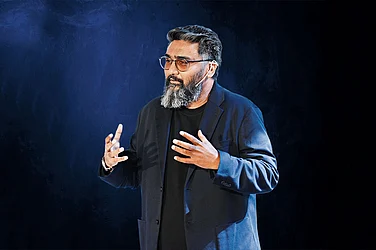The fintech ecosystem in India took many shortcuts in the name of innovation, but we firmly believe that this is lazy innovation, said Sivaram Kowta, President of Banking at Zeta.
Kotwa further highlighted that fintechs can succeed in sourcing because of their extensive reach and deep understanding of digital technology, which banks do not have. However, the balance sheet and P&L should remain under the control of regulated entities, he added.
Zeta, which focuses on providing bank software and technology services to banks and fintechs, aims to break even in the next 18 to 24 months. The company’s India arm reported a profit after tax of Rs 119.82 crore in FY24 from Rs 21.94 crore in FY23. Additionally, the company’s revenue from operations increased to Rs 893.12 crore in FY24 from Rs 816.19 crore in FY23.
Speaking to Outlook Business, Kowta talked about the challenges in the fintech space, credit on the UPI model, and the importance of regulatory guidelines by the RBI.
You mentioned earlier that your company expects to achieve profitability within the next 18 to 24 months. Is the timeline still on track? How are global operations progressing toward profitability?
Yes, we view it as a single profit and loss statement (P&L). With the way our business is scaling, we see a good opportunity to break even within the 18 to 24-month period. The nature of our business involves selling to large enterprise clients, and signing a contract can take a long time. Once signed, it takes us a few years to implement and make them go live, and potentially another year for them to scale on the platform. It’s a two- to three-year journey with each client.
Looking at our existing relationships and signed contracts, we are confident that we are on track to break even in the next 18 to 24 months. We continue to make adjustments, but by and large, we are on track.
Read: Want to Rebuild Trust in Fintech, Not Just Raise Capital, Says Mobikwik CEO
You’ve been bullish on credit-on-UPI products for a while. What do you believe gives them an edge over traditional methods like credit cards and personal loans?
Credit on UPI is essentially a combination of two things: the ability to provide credit and the rails on which it is provided. You can access credit through a credit card, a personal loan, or a credit line on UPI (CLOU). UPI has made it easier by allowing you to access credit directly at the point of spending by scanning a QR code, rather than tapping into your bank account. This on-demand credit system, much like a credit card, represents a revolutionary shift. Credit lines on UPI are different from credit cards.
Credit cards typically have high costs due to the involvement of networks like Visa and Mastercard, physical cards, and complex processes. In contrast, UPI credit lines have lower costs since they don't involve physical cards or intermediaries, making them more accessible. This opens the door for banks to offer smaller loans. With a credit card, banks often require a minimum credit of Rs 50,000, while many people may only need Rs 5,000 to Rs 20,000, which is more suited to the UPI credit line model. Moreover, UPI-based credit lines allow direct interaction between banks and merchants, bypassing the need for acquirers or POS machines. Banks can offer zero-cost EMIs through commercial agreements with merchants, without the need for complex technical setups. This makes the process more efficient, providing a huge advantage for banks and offering customers more control and access to on-demand credit.
In terms of business health, how do you assess your current position in the market?
We are a technology service provider, not a typical fintech. We don’t operate in the market ourselves; we serve banks by providing them with the technology they need. We are currently powering HDFC’s credit line on UPI, which will be launched in January or February. We are in advanced talks with another three to four banks to bring similar products to market. We don’t do tie-ups as such; we provide the technology and infrastructure, like Microsoft Word does for writing an article.
Read: RBI Gives SRO Recognition to Fintech Association for Consumer Empowerment
We offer a service called "Digital Credit as a Service," which covers everything from assessing a customer’s creditworthiness to managing the lifecycle of their credit, including transactions, statements, and operations. We provide the platform, security, and support needed for banks to run these systems. The banks handle marketing and customer targeting, but we manage everything else behind the scenes.
What are your plans for business growth in 2025?
We don’t have specific new launches planned for 2025, as we already have a broad portfolio. However, we are very excited about our offering of "Digital Credit as a Service," particularly the credit line on UPI. One challenge with the current banking system is fragmentation in how credit is provided—banks may offer different products like credit cards or personal loans, but the overall view of a customer’s credit is scattered.
Read: Sachin Bansal's Troubles Mount as RBI Bars Navi Finserv from Issuing New Loans
We provide a unified view of credit, which allows banks to offer real-time credit maximization and optimal allocation. We focus on risk and fraud management and digital customer acquisition, which is where we believe the future of credit will go. Our platform is also a pay-as-you-go model, which makes it easier for banks to connect with us without needing to make large upfront investments.
Do you have any plans for any tie-ups in future?
We are currently working with HDFC and Pluxee in India, and internationally, we are working with Cardworks, FIS, and Sparrow in the US. We have about 20 million live accounts across these clients. HDFC is our largest partner in India, and we manage several of their products, including PayZapp, which has 15 million users. We are also working with HDFC on their credit line on UPI, and there are more engagements we are discussing with them. Our collaboration with HDFC has generated significant interest from other banks, especially since the results from PayzApp have been encouraging in terms of user growth, engagement, and retention.
How do you address the risk associated with the Buy Now, Pay Later (BNPL) models, especially with the increasing regulatory scrutiny from the RBI?
We strongly support the RBI’s actions and believe that finTech should focus on innovation within the regulatory framework. In our view, "FinTech" is not the right term; it should be either "Fin" or "Tech." Zeta believes in using technology to enable innovation while maintaining proper risk management practices. The BNPL model has led to high NPAs (non-performing assets), sometimes as high as 15-20 per cent. The risks of these products have caused concern, as they have often been pushed without proper risk management or consumer protection, which has led to regulatory intervention. We see this as lazy innovation.
We believe the future of fintech in India will be built around specialized players who focus on risk management and fraud prevention, as well as customer experience. The key is that the balance sheet and P&L management should be left to regulated entities like banks. We believe that the credit line on UPI offers a much safer way to implement BNPL, where the bank is underwriting the risk. The RBI’s new FLDG (First Loss Default Guarantee) guidelines have clarified the roles of fintechs and banks, allowing fintechs to focus on areas like customer acquisition, fraud management, and digital distribution, while banks manage the financial risk.
How has your exposure to NBFCs been in light of the recent caution expressed by the RBI?
We haven't had any negative exposure to NBFCs. We work with a few smaller NBFCs that are not part of the current regulatory concerns. We also work with HDFC, which is not facing any issues. The recent regulatory action around NBFCs is aimed at addressing predatory pricing and ensuring that practices like surge pricing are not abused. The regulator is ensuring that financial institutions are fair in their operations to protect the broader financial ecosystem. We believe that as long as the market players follow fair practices and ensure that customers are creditworthy before lending, it will be beneficial for the economy. The regulator is not likely to back down and will continue to enforce these strict rules, which are in place for the good of the country. Fintechs that innovate while adhering to these rules will thrive in the long term.



























